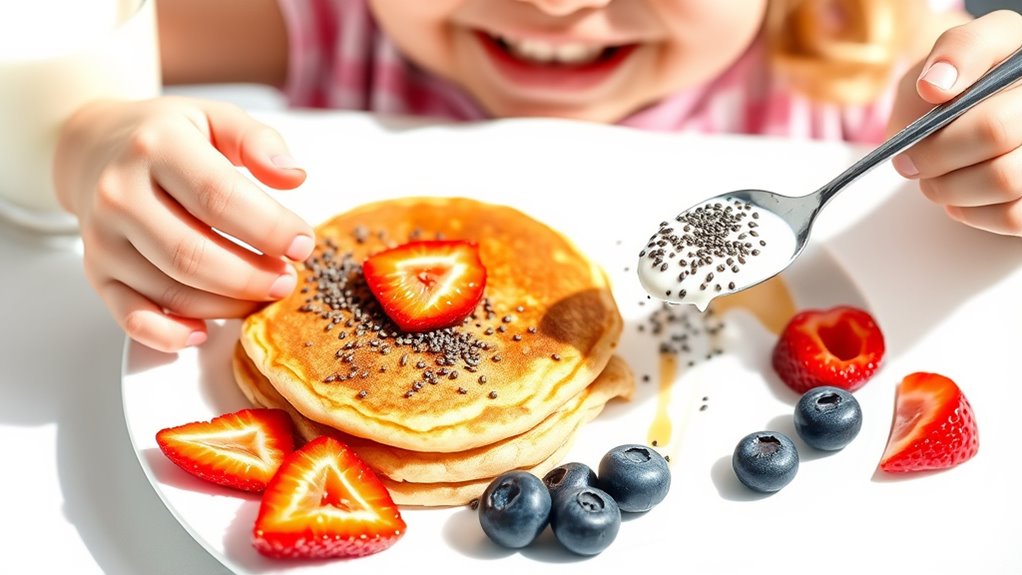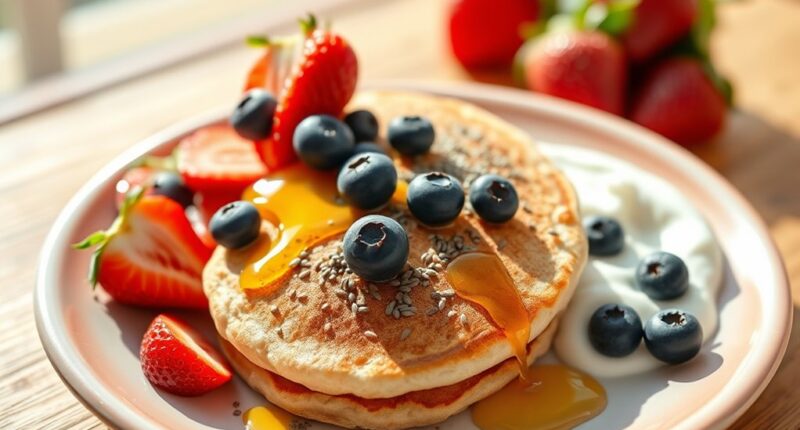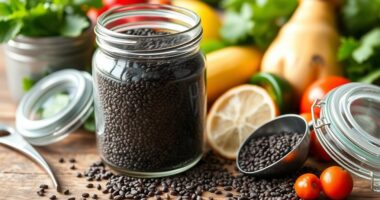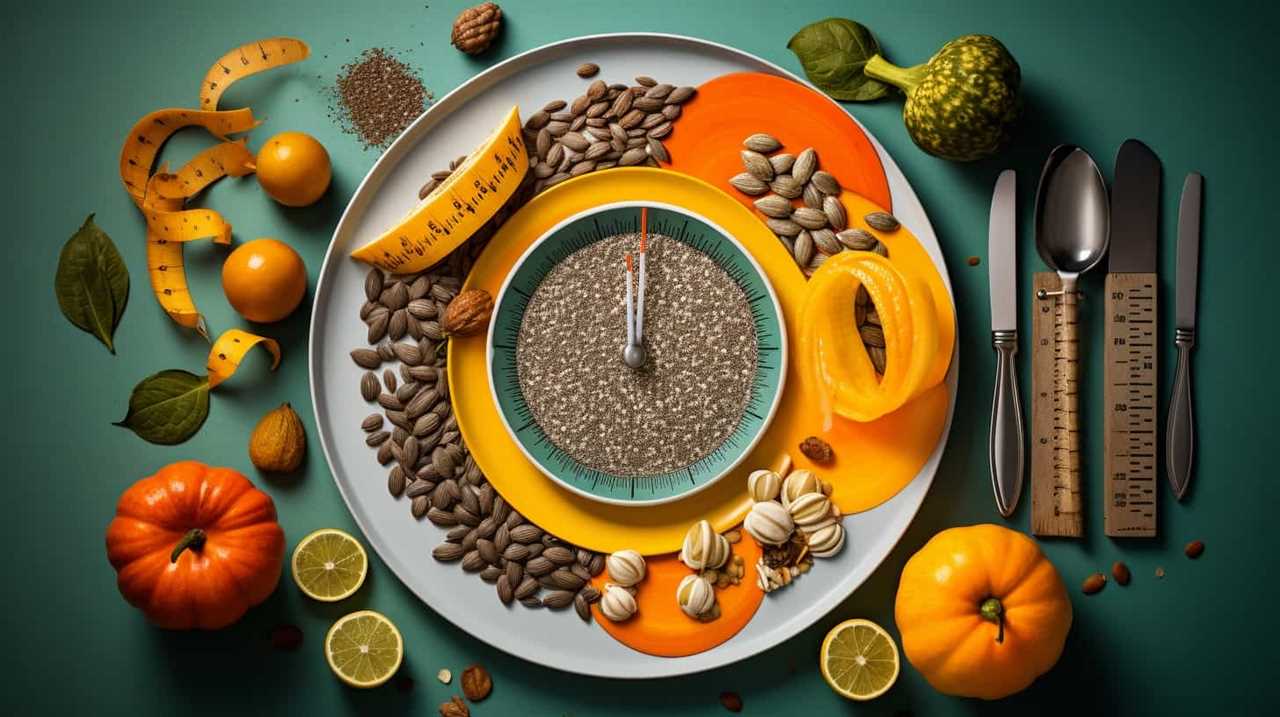To incorporate chia seeds into your child’s meals, try mixing soaked seeds into smoothies, yogurt, or oatmeal for added nutrients and texture. You can also make chia seed pudding or stir them into pancake and muffin batters. Sprinkle them on cereals, fruit salads, or snacks for a fun crunch. These simple ideas enhance flavor and nutrition without overwhelming your child’s palate. Keep exploring for more creative and tasty ways to make healthy eating enjoyable.
Key Takeaways
- Mix soaked chia seeds into smoothies or yogurt for added nutrients and appealing textures.
- Incorporate chia seeds into baked goods like muffins or pancakes for moisture and health benefits.
- Use chia seed pudding as a colorful, fun, and nutrient-dense snack for children.
- Sprinkle chia seeds on cereals, fruit salads, or granola bars to add crunch and boost nutrition.
- Experiment with embedding chia seeds into favorite recipes to promote healthy eating habits seamlessly.

Incorporating chia seeds into child-friendly meals is a simple way to boost their nutrition without sacrificing taste. These tiny seeds pack a powerful punch of nutritional benefits, making them an excellent addition to your child’s diet. Chia seeds are rich in omega-3 fatty acids, fiber, protein, vitamins, and minerals, all of which support healthy growth, brain development, and digestion. Because they have a mild flavor and a unique gel-like texture when soaked, you can easily blend them into a variety of foods without altering the taste considerably. This versatility makes chia seeds ideal for creating creative recipes that appeal to kids’ tastes while enhancing their nutritional intake.
Boost your child’s nutrition effortlessly with chia seeds’ mild flavor and versatile, nutrient-packed benefits.
One effective way to introduce chia seeds is by mixing them into smoothies. Blend a spoonful of soaked chia seeds into your child’s favorite fruit smoothie for added thickness and nutrients. The seeds not only boost the fiber content, helping with digestion, but also add a subtle crunch that kids often find fun. You can also incorporate chia seeds into yogurt or oatmeal, stirring them in overnight so they soften and expand. These options provide a creamy, satisfying snack or breakfast that’s both delicious and nourishing. For a fun twist, consider making chia seed pudding by combining the seeds with milk and a touch of honey or fruit puree. Let it sit in the fridge overnight, and you’ll have a colorful, nutrient-dense treat that children love.
Baking offers another opportunity to include chia seeds in meals your kids will enjoy. Add them to pancake or muffin batter for an extra boost of fiber and omega-3s. Since chia seeds absorb liquid and swell, they help improve the texture of baked goods, making them moist and tender. You can also sprinkle them on top of cereals, granola bars, or fruit salads, adding a crunchy texture and nutritional punch. When you get creative with recipes, you not only make mealtimes more appealing but also foster healthy eating habits by embedding essential nutrients seamlessly into dishes your kids already enjoy.
Additionally, incorporating solar-powered kitchen appliances can make meal preparations more environmentally friendly and energy-efficient, supporting overall green living habits.
Incorporating chia seeds into your child’s meals doesn’t have to be complicated. With a little experimentation and creativity, you can find numerous ways to enhance their diet naturally. The key is to think beyond traditional uses—try mixing, baking, or topping with chia seeds—and watch as your child benefits from the added nutrients without noticing a change in flavor. This simple step can make a notably difference in their overall health and well-being, encouraging them to develop a positive relationship with nutritious foods for years to come.
Frequently Asked Questions
Are Chia Seeds Safe for Children With Allergies?
Chia seeds can be safe for children with allergies, but you should be cautious if they have nut allergies or seed sensitivities. While chia seeds aren’t nuts, some children may react if they have seed sensitivities or cross-reactivity. Always introduce new foods gradually and consult your pediatrician before adding chia seeds to your child’s diet, especially if they have known allergies or sensitivities, to guarantee safety.
How Much Chia Seeds Is Appropriate for Toddlers?
You should give toddlers about 1 teaspoon of chia seeds daily. Since only 2 teaspoons contain about 10 calories, portion control is key to prevent overdoing it. The seed texture can be a fun addition, as chia seeds become gel-like when soaked, making meals more interesting. Start small, observe your child’s reactions, and gradually increase the amount to ensure they enjoy the benefits safely.
Can Chia Seeds Replace Other Sources of Fiber?
Yes, chia seeds can substitute some other fiber sources in your child’s diet. They offer a high fiber comparison and provide essential nutritional benefits like omega-3s, protein, and antioxidants. Incorporating chia seeds into meals can boost fiber intake efficiently, but it’s important to balance them with other fiber-rich foods to guarantee your child gets a diverse range of nutrients. Always start with small amounts to prevent digestive discomfort.
Do Chia Seeds Affect Children’s Digestion or Cause Bloating?
Chia seeds are like tiny boats sailing through your child’s digestive system, offering gentle digestive benefits. They usually don’t cause bloating when introduced gradually, and their high fiber content can help regulate digestion. However, too many might lead to bloating concerns or discomfort. To avoid this, start with small amounts, encourage your child to drink plenty of water, and monitor how their body responds to these nutritious seeds.
What’s the Best Way to Introduce Chia Seeds to Picky Eaters?
You can introduce chia seeds to picky eaters through creative recipes that mask their taste. Try mixing them into smoothies, yogurt, or puddings, where the subtle flavor blends seamlessly. Let your child help choose recipes or add toppings to make it fun. Gradually increase the amount, and over time, they’ll enjoy the added texture and health benefits without fussing over the taste.
Conclusion
So there you have it—adding chia seeds to your child’s diet is the ultimate parenting hack. Who knew that tiny, tasteless seeds could turn your child’s favorite snack into a superfood fiesta? Just sprinkle, mix, and watch them unknowingly boost their nutrition while pretending they’re eating plain old pudding or pancakes. It’s practically magic—because nothing says “parent of the year” like sneaking healthy stuff into their meals without a fuss. Cheers to guilt-free, nutrient-packed snacks!








